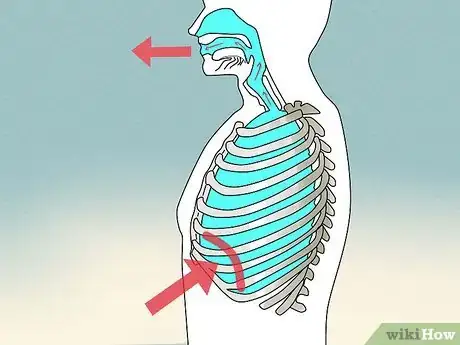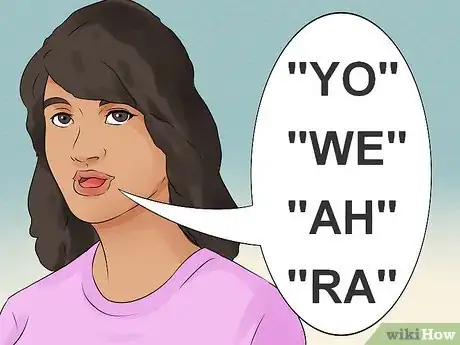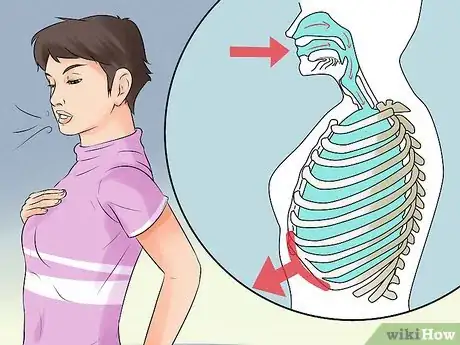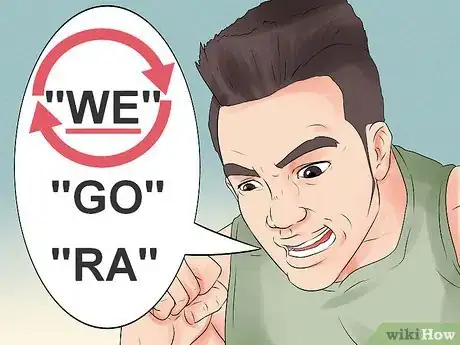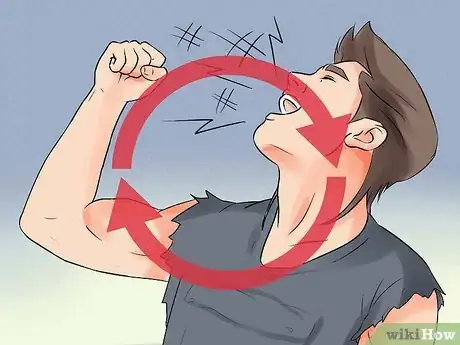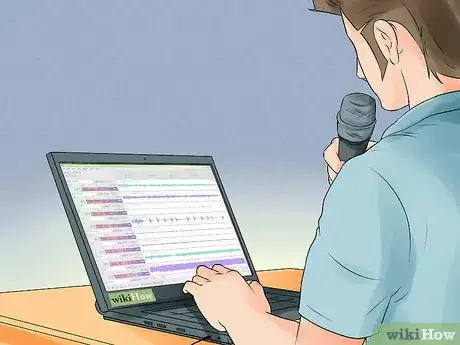This article was co-authored by Amy Chapman, MA. Amy Chapman MA, CCC-SLP is a vocal therapist and singing voice specialist. Amy is a licensed and board certified speech & language pathologist who has dedicated her career to helping professionals improve and optimize their voice. Amy has lectured on voice optimization, speech, vocal health, and voice rehabilitation at universities across California, including UCLA, USC, Chapman University, Cal Poly Pomona, CSUF, CSULA. Amy is trained in Lee Silverman Voice Therapy, Estill, LMRVT, and is a part of the American Speech and Hearing Association.
There are 8 references cited in this article, which can be found at the bottom of the page.
wikiHow marks an article as reader-approved once it receives enough positive feedback. In this case, 86% of readers who voted found the article helpful, earning it our reader-approved status.
This article has been viewed 623,697 times.
Harsh growls are a touchstone of black metal, death metal, and other extreme forms of music. If you want to know what it takes to growl like your favorite singer, you can learn the ins and outs of exhaled and inhaled growls, as well as how to sing properly without hurting your voice. The question is, how do you growl? Just read further and you will be growling in no time!
Steps
Exhaled Growls
-
1Breathe from your diaphragm. Sit with your back straight, and just hum with your normal voice and mouth closed. Put your hand on your stomach, just below your ribs, and hum a few times in short bursts. When humming, one automatically uses the diaphragm and abdominal muscles, so you should feel your abdomen goes in, while your chest and shoulders aren't moving. Breathe from that spot when you want to growl.[1]
- Put your hand on your abdomen and hum with your mouth closed. Gradually increase the volume. Feel how your abs are shrinking towards the inside? This means that your diaphragm is relaxing and pushing air out. That's where the sound should be coming from.
-
2Pinch your throat. Open your jaw and make an "O" shape with your lips. Pull your tongue back to the back of your throat. The tighter you pinch the back of your throat, the higher the pitch of your growl will be. Move your tongue forward slightly and loosen the pinch, and your growl will be a little lower.
- Try letting a little air out. It should rattle a little at the back of your throat, without really having to make much sound at all. Rattling is a sign that you've got the right shape.
Advertisement -
3Exhale forcefully, but evenly. Practice breathing deep into your diaphragm and positioning your throat correctly, then try exhaling a few times, evenly but forcefully enough to get a good amount of sound from your throat. You should hear a good, low growl that sounds good for animal impressions and metal songs alike.[2]
- Draw out the growl for a few seconds and let it trail off. Practice bringing the volume up and down, and changing the pitch slightly. It'll take a little practice.
- Keep your hand on your stomach to make sure you're breathing as deeply as possible, and pushing the air from deep in your diaphragm.
-
4Practice growling nonsense syllables. To help you channel your throat sounds into something that's like music, it's important to practice forming syllables and changing pitch. The following syllables are all good to practice in your routine, forming them as evenly and smoothly as possible:[3]
- Yo
- We
- Ah
- Ra
-
5Don't chop the ends off. When you're growling, if you cut off your growl very abruptly, you'll risk losing your voice. The force necessary to stop the sound can wreak havoc on your vocal cords, and you'll end up with a sore throat if you cut off your growls suddenly, instead of letting them trail off.
-
6Practice changing the pitch. For black metal style vocals, you often want to growl with a higher pitch. Keep your tongue down and keep your head tilted up a bit, practicing pinching your throat enough to get the right kind of tone and change in pitch.[4]
Inhaled Growls
-
1Use inhaled growls for higher pitched songs. Generally speaking, inhaled growling sounds more "piggy" and slightly higher pitched, but it can also sound demonic and devilish, and you can do a whole lot with the technique. Really, it sounds a lot similar, but it's another little trick you can add to your extreme singing arsenal, to make your abilities a little rounder. It's only a minor difference from exhaled growls.
-
2Breathe from your diaphragm. Similar to the exhaled growl, your want to keep your focus on your diaphragm. With all singing, good breath support is important for a good tone. Put your hand on your stomach and feel your diaphragm going in and out as you breathe.[5]
- To inhale, expand your abdomen and lower back ribs, while not moving the chest and shoulders. Practice breathing from deep in your stomach, not from your throat, to make your growl as deep as possible.
-
3Make the throat pinch and inhale. Make an "O" with your lips, open your jaw, and bring your tongue back in the same way as you did for the exhaled growl. Start inhaling in the same way you exhaled, breathing deeply into your diaphragm.
- Increase the volume and force gradually to get a sense of how much you need to breathe in to get the kind of sound and pitch you're looking for. Play around with it for a while until it feels comfortable to you.
-
4Start with the syllable "we." The most common inhaled growl seems to be around the "we" syllable, because it feels the most comfortable. This is often used to start songs in the death or black metal genres, allowing you to let loose with a lot of volume. Start practicing around "we" until you get comfortable, then try more syllables as you're working on your growls:
- Go
- Ra
- Die
-
5Practice alternating between exhaling and inhaling. A good metal vocalist can alternate between the two, so you can sing a whole lot at once, as the song calls for. The more seamlessly you can shift back and forth between exhaled and inhaled growls, the more seamless and virtuosic your abilities as a growler.
- Write out some lyrics and practice singing half in an exhaled growl and half inhaled. Try out some Opeth[6] for practice: (Exhaled) "We enter winter once again" / (Inhaled) "Naked freezing from my breath."
Growling Vocals
-
1Always warm up your voice first.[7] Growling puts more strain on your throat than possibly any other type of singing. It involves your vocal cords less, but it can give you a sore throat pretty quickly. It's not always necessary to warm up your vocal cords with fancy exercises, but warming up your throat a little is important. Never start cold.[8]
- Drink warm tea with honey to help warm up your throat. Avoid drinking things like soda and milk, which can make your throat kind of mucous-coated, making it hard to sing.
- Don't smoke. Lots of inexperienced singers think a couple cigarettes is the fast-track to a rough voice. It's really the fast-track to addiction and disease. The proper form will work a lot better.
-
2Try growling words. Even though they're hard to make out, eventually, you'll probably want to be growling lyrics instead of random syllables, right? To work on this, pick out some of your favorite metal lyrics and practice phrasing them and forming them in your growled technique.
- Don't try to make it sound just like the original singer. Everyone's growl is different. If your's is lower or higher, that's not a bad thing. Embrace your unique voice.
- If you don't want to ape someone else's song, pick a passage from a book you're reading, or some old English poetry that rhymes and might sound cool death metal style. It's just practice.
- Write your own metal lyrics, if you want to work with something original. Good themes always include death, demons, dragons, snakes, winter, bitterness, and darkness. Go for it.
-
3Keep your body relaxed.[9] Form the voice with your mind, express it with your folds. Don't try to force the vocal folds to do what they shouldn't do. Keep your throat relaxed.
- Intense growling shouldn't hurt. If it does, revise your technique and make sure you're breathing from your diaphragm.
- When you start out growling, you use muscles that you never used before at such a strong level. If the muscles around your neck or throat are tired, stop growling until its over and start again.
-
4Practice consistently. This is a lot like lifting weights at the gym. You use your muscles much more intensely than normal and then wait for them to restore before using them at a higher level each time. If you stop growling for a long period of time, your growling skills will decrease.
- If you pick up on growling after a long break, take it easy, as your stamina will be much worse. Though, you will redevelop much faster than the first time.
-
5Record yourself. This is a really helpful way to find whether or not you're hitting the right volume, pitch and style. It's recommended to record, listen and listen again only after few hours, so your mind will be able to spot even the smallest mistakes.
- It doesn't need to be fancy, or along with a musical track. Just use your phone and see how it sounds, or open up a GarageBand file or an Audacity file and sing along to a song you like to get a better sense.
-
6Do short sessions. Black metal type of vocals may hurt if pushing too hard or after very long and intense sessions. Practice no more than 10-15 minutes a day in the beginning, it will take time for your vocal cords to adjust to the abuse and eventually you will sound better.
- If it hurts badly in the beginning though, stop and revise your technique. Maybe you're pushing too much.
Expert Q&A
Did you know you can get expert answers for this article?
Unlock expert answers by supporting wikiHow
-
QuestionHow do you growl properly?
 Amy Chapman, MAAmy Chapman MA, CCC-SLP is a vocal therapist and singing voice specialist. Amy is a licensed and board certified speech & language pathologist who has dedicated her career to helping professionals improve and optimize their voice. Amy has lectured on voice optimization, speech, vocal health, and voice rehabilitation at universities across California, including UCLA, USC, Chapman University, Cal Poly Pomona, CSUF, CSULA. Amy is trained in Lee Silverman Voice Therapy, Estill, LMRVT, and is a part of the American Speech and Hearing Association.
Amy Chapman, MAAmy Chapman MA, CCC-SLP is a vocal therapist and singing voice specialist. Amy is a licensed and board certified speech & language pathologist who has dedicated her career to helping professionals improve and optimize their voice. Amy has lectured on voice optimization, speech, vocal health, and voice rehabilitation at universities across California, including UCLA, USC, Chapman University, Cal Poly Pomona, CSUF, CSULA. Amy is trained in Lee Silverman Voice Therapy, Estill, LMRVT, and is a part of the American Speech and Hearing Association.
Voice Specialist
-
QuestionCan I give myself vocal damage by going from low to high pitched growls?
 Community AnswerIf you don't prepare, it may well cause pitch and vocal damage. If you would like to try these high and low vocals, it would definitely be a good idea to warm up your voice by doing vocal exercises and preparing to sing. You can find lots of vocal exercises on YouTube.
Community AnswerIf you don't prepare, it may well cause pitch and vocal damage. If you would like to try these high and low vocals, it would definitely be a good idea to warm up your voice by doing vocal exercises and preparing to sing. You can find lots of vocal exercises on YouTube. -
QuestionThen why are you teaching us inhaled growls if it's bad for you?
 Community AnswerGrowls can stress your voice; if you don't want to take that chance, don't growl.
Community AnswerGrowls can stress your voice; if you don't want to take that chance, don't growl.
Warnings
- Monitor your breathing. Improper breathing may result in bad technique and, eventually, damage.⧼thumbs_response⧽
- Don't drink alcohol or smoke. Some say it helps, but it doesn't help your vocals nor your general health.⧼thumbs_response⧽
- Never push yourself too far. If the vocals are too quiet during a performance, so be it. You don't want to ruin your throat this way.⧼thumbs_response⧽
- Inhaling growling could damage your vocal chords in various ways, but it doesn't hurt usually. Overall it's recommended to avoid inhaled vocals.⧼thumbs_response⧽
- If you are feeling unwell, do not try this as it can damage your throat and your vocal chords more as you are sick.⧼thumbs_response⧽
References
- ↑ https://www.youtube.com/watch?v=bOKipTeGezo
- ↑ https://www.youtube.com/watch?v=6cB3o-VuGkc
- ↑ https://www.youtube.com/watch?v=WFeYs2Fee2Y
- ↑ https://www.thenakedvocalist.com/create-vocal-effects/
- ↑ https://www.youtube.com/watch?v=MEPpmol6_I8
- ↑ http://www.darklyrics.com/lyrics/opeth/blackwaterpark.html#1
- ↑ Amy Chapman, MA. Voice & Speech Coach. Expert Interview. 18 October 2019.
- ↑ https://www.youtube.com/watch?v=LUXN8_9WIXQ
- ↑ Amy Chapman, MA. Voice & Speech Coach. Expert Interview. 18 October 2019.
About This Article
If you want to growl, you can try an exhale technique that begins with you sitting straight, putting your hand on your stomach just below your ribs, and humming in short bursts. This will help you find your diaphragm, which is where you want your sound to come from. Next open your jaw to make an “O” shape with your lips, pull your tongue to the back of your throat, and forcefully exhale from your diaphragm. For a higher pitch growl, use an inhale method similar to the exhale method, just adding the sound as your belly and ribs expand. If you want to learn how to produce different sounds while you're growling, keep reading the article!
